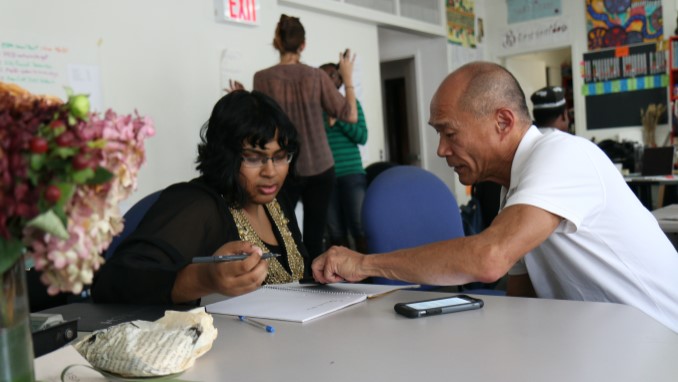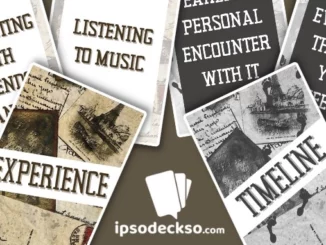
Articles in Ludogogy, obviously, focus often on games, their mechanisms and application in learning. However, we should not ignore the other half of the games-based learning approach, the application of robust and well-tried learning theory.
One such is Knowles Andragogy and readers may be more or less familiar with the assumptions and principles of this theory of Adult Learning. Depending on where you get your information the numbers of these may differ, as Knowles added to them himself during the time he was developing the theory (in the 1980s), and later theorists developed it further.
Andragogy deals with the specific considerations of teaching and learning for adults, as opposed to Pedagogy (teaching and learning for children). However, the term ‘Pedagogy’ is also widely used to mean ‘learning approach’ or ‘specific learning practice’ (including in Ludogogy articles), so do not assume it always refers to children – context will usually inform.
Assumptions about Adult Learning
Five assumptions about the way adults feel about and approach the task of learning are:
- Self-concept: While child learners are dependent on others, as they mature to adulthood, they become more self-directed.
- Learner experience: Adults bring a wealth of experience to the learning process.
- Readiness to learn: As people mature their priorities change to value learning about their role in society.
- Orientation to learning: As people become adults they move from focus on subjects to focus on application and towards a preference for immediate rather than delayed application of learning.
- Motivation to learn: While younger people can be motivated to learn by extrinsic rewards (treats), adult learners need to find intrinsic rewards in the learning they undertake (the learning contains its own reward)

Principles of Creating Learning for Adults
Principles can be extrapolated from the above about what adult learning should look like:
- Adults need to be involved in the planning and evaluation of their instruction.
- Experience (including mistakes) provides the basis for learning activities.
- Adults are most interested in learning subjects that have immediate relevance to their job or personal life.
- Adult learning is problem-centred rather than content-oriented.
To the above can be added:
- Adults must want to learn. Effective learning only occurs when learners have autonomy to direct their own learning and are intrinsically motivated to engage with the specific topic or skill being offered.
- Experience affects adult learning. While prior experience can be an asset when brought to a learning situation, consideration has to be given to the idea that it can also be a liability if the prior knowledge or experience is incorrect.
- The learning environment can be optimised for adults to allow greater autonomy and understanding of their goals, by being designed for collaboration, networking and to be flexible to needs. This will often result in a more informal situation than those used with children.
What do Andragogical Games Look like?
If we were to use these principles as the basis to build a gameful learning environment or a learning game, what might such an Andragogical game look like, and what existing examples can be drawn upon for inspiration?
To satisfy the principle of self-direction, any game we design must be more than a linear delivery of content in a game-like way. Players should be able to make meaningful decisions, that have real impact within the game setting, and in the way that decision informs the current, and next, step they take in their learning path. This in turn implies a certain breadth in the available actions and decisions. De-emphasising the role of chance is important, as players will feel less autonomy if their efforts can be derailed by the roll of a die, or the turn of a card. The range of available actions seen in many Eurogames provide good examples to work from and these games are not generally too reliant on chance.
See:
Wingspan – the ‘Engine Building’ mechanic in this game makes for high emergent complexity of consequences from relatively simple actions, meaning that players can choose a variety of strategies in play.
Settlers of Catan – despite some elements of chance, Catan allows players to develop solid strategies, making the combination of mechanics in this game a good representation of the interaction between planning and ‘external factors’.
Terraforming Mars – another game which focuses on Technology Trees for players to implement strategies. Ongoing scores inform players how close they are getting to their shared goal, and allow them to adjust strategies to be more effective.
Learning from Experience
‘Learning by Doing’ is something that games can obviously deliver extremely well, but there are several considerations if you are to do this well. The consequences of the ‘doing’ must be appropriate, facilitating the required learning. These consequences must be clearly articulated in a timely manner. There must be opportunities to reflect on results of decisions in the game, to hypothesise, and to experiment with different decisions, next time around to cement learning, and ‘learn from mistakes’. Failure should be ‘low-cost’ so as not discourage players from engaging willingly in the ‘fail, reflect, hypothesise, experiment’ cycle. Again, Eurogames provide good examples. Player elimination is rare in such games, as they are designed to keep people playing, as socialisation is a goal of play. Sometimes, all that is needed to allow reflection is that a game is turn-based, giving players sufficient ‘down-time’. However, for more complex learning outcomes, or where learners/players would benefit from discussion with other players (as opposed to other characters within the game), do consider facilitated ‘discussion breaks’ where the magic circle is exited temporarily.

See:
The Mind – the team fail quickly and frequently, and players can thus try new strategies each round, although the rule about not talking does mean they have to experiment alone.
Pandemic – collaborative quest- based games which feedback to players promptly of how ‘well’ they are doing (in this case through the number of virus cubes on the board), facilitate in-game strategy discussion between actions. It is also worth mentioning the ‘Legacy’ version of the game, where some consequences of actions (including failure) are irrevocable, if that is the kind of experience you want to create.
Magic: The Gathering – In games such as this, players will often spend the time during which their opponent is acting, not only reacting to their actions, but also planning their own strategies, sometimes many turns in advance.
Correcting Learners without Confrontation
Games often provide a much less confrontational way to ‘correct’ learners without directly pointing out that their previously held knowledge or ideas are ‘wrong’. Discovery through play is one way to implement this, and does not require that the learner expose themselves by revealing what they ‘know’ or ‘believe’ in front of other learners. In game settings, the cost of failure is much ‘cheaper ‘ than it would be in reality, allowing, for example ‘do-overs’ and encouraging a cycle of experimentation until the ‘right’ solution (i.e. the one which allows them to progress in the game) is discovered.
See:
Mastermind (or Wordle) – codebreaking games very often include a mechanic where players can repeatedly hypothesise and experiment to receive information which will lead them to an ultimate solution.
Love Letter – Score and Reset games, completely (or partially) reset the conditions of the game either at the end of turn, or at some other condition, allowing repeated attempts to solve the central problem of the game. In this sense, Legacy games, such as Gloomhaven, are the polar opposite of this, implementing irrevocable changes to the gameworld, which cannot be rolled back.
Adult Learners Must See Relevance
It can be challenging to design in ‘relevance’ for every learner, in any kind of learning intervention. Knowles himself suggested researching the interests and needs of each adult learner. In practice, it is hard to see how this would work in many learning settings. If you have the same cohort of learners for sufficient time to get to know them, say, for example, in a higher or further education setting, then maybe this is possible. However, in many workplace learning settings, this would be a prohibitive overhead. And this is perhaps the Andragogy principle that games can satisfy where other approaches may fail. But if it is to do so, we cannot be thinking of an ‘out of the box’* solution, where all players follow a similar experience (albeit with autonomy to make free decisions within the game framework, as above). We have to be thinking more about the kinds of expansive (and immersive) ‘open world’ games where players are free to use multiple entry points and follow whatever path they choose through any number of experiences.

See:
Minecraft – creating a large scale, multi-faceted challenge in a ‘sandbox’ platform like Minecraft, e.g. building a sustainable city, allows players to pick their own relevant pathway to learning, and to achieving the challenge.
David Chandross kindly allowed Ludogogy to publish a chapter from his book. It describes exactly the sort of expansive open world referred to above.
Liber Domus – Eduardo Nune’s open-world platform for K12 education, provides a great example of the genre and how it can be used.
Games that Players Create in Play
Alternatively, (and more simply and cheaply), we could be looking at the kinds of games which players create in-play. An example of such a game would be 1000 Blank White Cards. There are also playful activities (as distinct from ‘games’) such as Lego® Serious Play®, which focus specifically upon individual reflection and contribution (even where that feeds into a socially-constructed knowledgebase), and therefore, are, by definition, relevant to each individual’s needs, experience and ability to contribute. Open play would also meet this requirement, although this is infrequently used with adults, as it potentially attracts even more objections of unsuitability than more structured games do.
Finally, games design itself provides an excellent vehicle for learners to create their own relevance, and has the added advantage that it embeds learning in transversal competencies such as systems thinking and design thinking.
See Erik Agudelo’s Toolkit 4 Creativity (TB4C) – a system for delivering deep learning through the affordances of game design.
Problem-based Learning

Most games, beyond the simplest ones like Tic, Tac, Toe, or games that are largely dependent on Chance, present players with the ‘problem’ of playing, or as Bernard Suits would have it ‘the voluntary attempt to overcome unnecessary obstacles’, and the further problem (in many cases) of strategising to play well enough to win. Therefore games-based learning is particularly suitable for creating circumstances for adults to engage in problem-centred learning. Particularly worthy of note here are games which use a ‘Quest’ mechanic to encourage learners to string together complex sets of strategies and decisions to achieve a larger end. And while this makes some think of high fantasy games with wizards and goblins, the mechanic can be applied to scenarios of any topic or structure, using for example, real life case studies, or implementing alternate (but still very real) realities or histories. It also has the advantage that a single quest can be structured from sub tasks which get progressively more complex as you move towards the ultimate goal. This is equivalent to the ‘scaffolding’ of learning, where each activity or builds on the learning from the previous one.
See:
Dungeons and Dragons – The fact that both players and the problems (dungeons) they face are categorised by ‘Levels’ means that capability and complexity can be matched to provide a consistently challenging experience.
Corrado de Sanctis’ DSBuilders challenges players to solve a complex problem (building the Death Star), a project with sufficient breadth to allow players diversity of strategy (and thus relevance) in play.
Games are Only Games if they are Voluntary
To return to Suits’ quotation above, there is a requirement for people to voluntarily engage in play – otherwise it is no longer play. This is directly equivalent to the principle of Andragogy which says that adults have to want to learn. But from a design perspective, this can present a problem. If a mandated game is not a game, and mandated learning is not learning, what do we do when we are creating workplace games-based learning which employees are obliged to engage in? Do we just accept that those who do not want to engage (either because they do not want to learn, or because they do not want to play) will not receive the benefits we designed in?
In practice, there are many ways in which non-players (and therefore, non-learners) may end up voluntarily entering the magic circle. If they see others participating, (and benefitting from the experience), they may well decide to participate. If they come to believe that they have skills or experience that can make play ‘better’ (they see others making errors), they may well ‘step in’.
But some may never take this step and the environment in which the game occurs should allow for this, giving non-players other ways in which they can participate, in a non-game way – which could be as simple as observation. But if observation alone is not going to be enough to facilitate learning for these people, non-game activities should be provided. A non-exhaustive list of suggestions might include web research, analysis of case studies, discussion groups. This can be particularly effective if the magic circle is made ‘permeable’, allowing information and input from non-players to enter the game. This permeability also allows non-players to become players at the point which best suits them, and for players to become non-players when their play is no longer voluntary.
See:
Treasure Hunt – the classic example of a game where the ‘game’ (rules and scoring), are dependent on interacting with the outside world, from where non-game items are brought into the magic circle.
Citadels – Player change their roles in each round, which is a feature which could be implemented to create a game structure which allows people to step in and out at will.
Pervasive games – this is the term used for games which expand the magic circle to include elements of the real world. Examples would include Pokemon Go or Assassin.
Pervasive Games in available from Amazon.
Lyric Games – a hard to define (RPG) sub-genre, which include solo journaling games, and writing prompts (but is also much wider than this). One important aspect of many lyric games is the reduction of distance between the player and the character they play, so these games often facilitate self-exploration. An example would be Steve Wright’s Hope Is Not A Plan, which is a solo journaling RPG about the trials of project management. (thank you, Joseph DeSimone for telling me about this game).
Games are Not ‘Just for Kids’
One of the objections that we often face as games-based learning professionals, is that games are ‘just for kids’, the implications being that we cannot use games for ‘serious’ learning, that we ‘trivialise’ the important business of workplace learning by making it gameful, or even that we are patronising adults by asking them to play to learn.
A direct mapping of a game’s mechanisms to a specifically ‘adult’ learning theory may help to make the case to skeptics, and if not, I hope it provides food for thought when you are creating your next learning intervention.
* It is important to note here that where the relevance to all learners can reasonably be construed as being the same, it is appropriate to create a game which will be ‘the same’ for all. This is most likely to occur where the game in question is being used for ‘training’ to a particular task or knowledge set, and that the cohort in question all have the same needs because they are all in the same job, or have the need to perform the same task. This is distinct from ‘learning’, which implies a more diverse cohort who will have more diverse needs and bring different experience to bear on the learning situation. It is ‘learning’ which is assumed throughout this article.
- James Bore – The Ransomeware Game - 13th February 2024
- Ipsodeckso – Risky Business - 23rd January 2024
- Review – Luma World Games - 15th December 2023





Be the first to comment